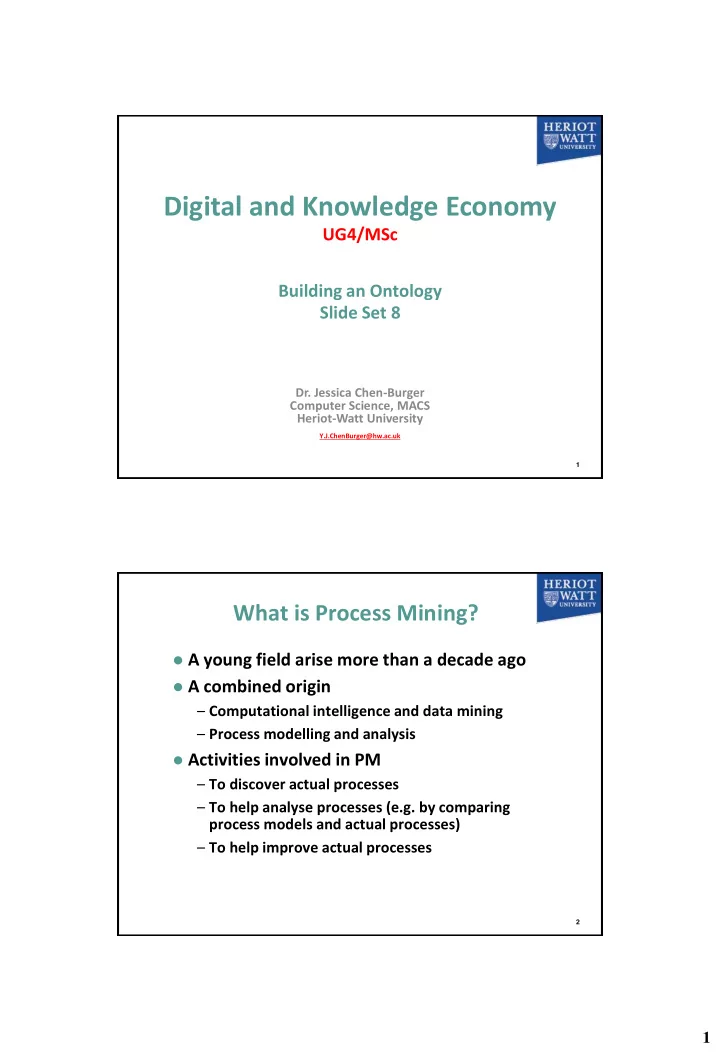

Digital and Knowledge Economy UG4/MSc Building an Ontology Slide Set 8 Dr. Jessica Chen-Burger Computer Science, MACS Heriot-Watt University Y.J.ChenBurger@hw.ac.uk 1 What is Process Mining? A young field arise more than a decade ago A combined origin – Computational intelligence and data mining – Process modelling and analysis Activities involved in PM – To discover actual processes – To help analyse processes (e.g. by comparing process models and actual processes) – To help improve actual processes 2 1
Why Process Mining? (1) To understand processes that actually happened To compare actual processes with processes that one thought to have been carried out To compare actual processes with standard processes To understand who carried out the processes To understand what resources are used/needed by processes To understand where processes are been carried out (location, organisation) 3 Why Process Mining? (2) To streamline and improve actual processes, e.g. – To reduce cost – To speed up processes – To reduce redundancy – To discover/remove irregularities To create improved standard process model To reuse process models 4 2
PM Three Functions (re-cap) Three types of PM 5 Event Log 6 3
7 Three Main PM Functions 8 4
Where to apply Process Mining? 9 10 5
Sample Control-Flow Diagram 1 11 Sample Control-Flow Diagram 2 12 6
Sample Control-Flow Diagram 3 [Source: Celonis slides] 13 The Event Log (re-cap) [Source: Celonis slides] 14 7
Event Logs May have to pull information from multiple places, e.g. – Database tables – Message logs – Mail archives – Transaction logs Making sense of pulled information and create an integrated event log, inc. – Activities that is temporal based – May include information flow – May include process flow – May include cost information – May include actor/role information – May include mechanism used in an activity 15 Problems in Event Logs Incorrectness – Errors in event logs – Assumed/recalled data, not always real data recorded Missing information – Missing events – Sparse entries in variables (of events) Missing definition (semantics) – Process and data level Need to preserve privacy and security – E.g. healthcare or financial data – Do you need consent from the actor that information are being recorded and the way information is being used? 16 8
Object Management Group Business Process Model and Notation (BPMN not examinable) And – parallel gateway Loop XOR – exclusive gateway 17 Basic Process Flow Control And gateway (parallel)(and-split/join) – All activities are executed – They can be executed in parallel, if running on a parallel machine/network Xor gateway (choice; exclusive gateway)(Xor- split/join) – Exactly one activity is executed Or gateway (inclusive gateway)(Or-split/join) – At least one activity is executed; – If more than one activity is executed, they can be executed in parallel, if running on a parallel machine/network 18 9
Process Mining Guidelines Event data should aim for high quality Log extraction should be driven by questions Basic process flow control should be supported in the process model, i.e. – and/or/xor gateway Events (stored in event logs) should be related to elements in the control-flow and process model Models are abstractions of the reality that are created to support certain goals Process mining is a continuous process 19 Challenges - 1 Find, merge and cleaning event data Dealing complex event logs having diverse characteristics, e.g. – Different sizes in cases – Large amount of different types of events to handle – Incomplete real-world samples – Too low level of abstraction of events Create representative benchmarks Dealing with concept drift – the process is changing while being analysed 20 10
Challenges - 2 Avoid representational bias by selecting a suitable process modelling language – Can it represent all of the basic/important processes? Balancing between quality criteria, i.e. – Fitness (show all links between PM and logs), – Simplicity (simple model) – Precision (no noise) – Generalisation (describe the domain, not just sample events) – Problems to capture real cases with low frequency 21 Challenges - 3 Cross-organisational mining, e.g. – End-to-end process in a Supply Chain – Cloud computing – different organisations executing the same/similar processes while sharing experiences, knowledge or a common infrastructure, e.g. salesforce.com – organisations may learn from one another Provide operational support (real-time) – Detect (and alert) – Predict - use historical data as guide – Recommend 22 11
Challenges - 4 Combine process mining with other types of analysis, e.g. – Operations management – Data mining (e.g. pattern discovery) – Predicting future (e.g. use simulation) – Visual analytics – automated analysis with interactive visualisation Improve usability for non-experts – Support living process model, not a static one – Use user-friendly UI, hide complexity Improve understand-ability for non-experts – Indication of data accuracy; – Support for results generated 23 Celonis Tool Demo http://www.macs.hw.ac.uk/~yjc32/proje ct/Teaching/DKE-2016-17/coursework-2/ – Demo 1 – Demo 2 24 12
Exercise - 1 What is process mining? Why is process mining useful? What are the main functions/types of process mining? How process mining interact with software systems? What sorts of results may be derived from process mining? What are the challenges? Given a real-world scenario, can you recommend a process mining solution, e.g. based on the 3 functions? 25 Exercise - 2 The Lothian Bus wishes to have a better understanding of their customers’ usage of their buses, in the interest of providing better services based on lower cost. They are interested in, e.g. – Where most of the customers get on the bus and where they take off – When they take the bus – When is the peak time – Where and when the traffic is congested – Whether buses are on-time Recommend relevant process mining techniques and explain why. 26 13
References IEEE CIS Task Force on Process Mining, Process Mining Manifesto, 2011: http://www.win.tue.nl/ieeetfpm/doku.p hp?id=shared:process_mining_manifesto 27 Reference (not examinable) • BPMN model: http://www.bpmn.org/ • Jon Espen Ingvaldsen and Jon Atle Gulla, Model-Based Business Process Mining: https://scholar.google.com/citations?use r=lq5InSEAAAAJ&hl=en 28 14
Recommend
More recommend